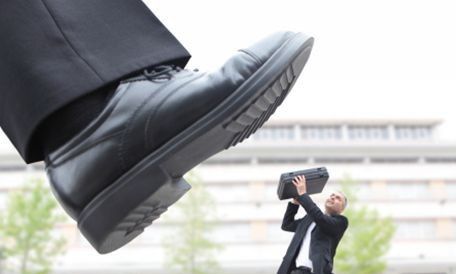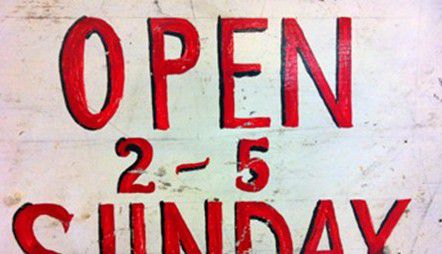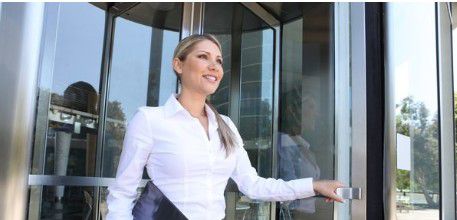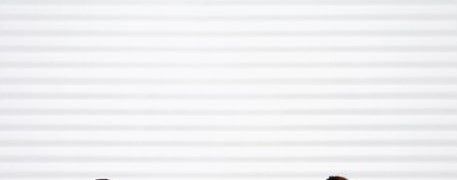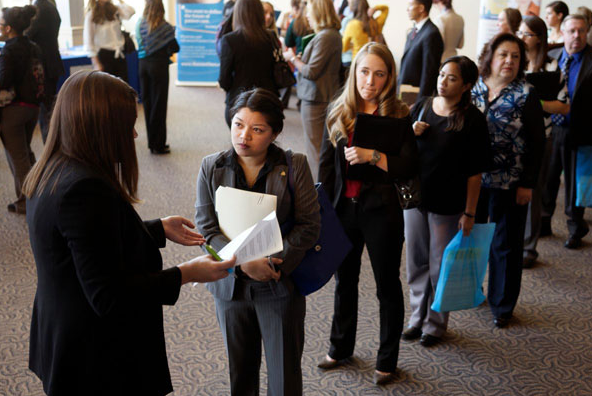LAPD (King Beating) Trial
|
The Trials of Los Angeles Police Officers' in Connection with the Beating of Rodney King By Doug Linder (2001) It seemed like an open-and-shut case. The George Holliday video, played on television so often that an executive at CNN called it "wallpaper," showed three Los Angeles police officers——as their supervisor watched—— kicking, stomping on, and beating with metal batons a seemingly defenseless African-American named Rodney King. Polls taken shortly after the incident showed that over 90% of Los Angeles residents who saw the videotape believed that the police used excessive force in arresting King. Despite the videotape, a jury in Simi Valley concluded a year later that the evidence was not sufficient to convict the officers. Within hours of the jury's verdict, Los Angeles erupted in riots. When it was over, fifty-four people had lost their lives, over 7,000 people had been arrested, and hundreds of millions of dollars worth of property had been destroyed. Why did the twelve members of the jury fail to convict any of the officers? Was the jury racist, as some charged? Or did the jury see something in the evidence that justified the brutality witnessed on the Holliday videotape? March 3, 1991 On the night of March 2, 1991, Rodney Glen King watched a basketball game and drank forty-ounce bottles of Olde English 800 at a friend's home in suburban Los Angeles. After the game, King proposed a trip——possibly to pick up some girls. King and two friends, "Pooh" Allen and Freddie Helms, took off driving west down the 210 freeway. At 12:30 A.M., a husband-and-wife team of the California Highway Patrol, Tim and Melanie Singer, spotted King's Hyundai behind them driving at a very high speed. The Singers exited at the Sunland Boulevard off ramp and returned to the freeway to chase the speeding car at speeds of up to 117 miles per hour. King ignored the flashing lights and sped off an exit ramp. He ran a red light, nearly causing an accident, before finally coming to a stop near the entrance to Hansen Dam Park, at the intersection of Osborne Street and Foothill Boulevard. Within seconds, three Los Angeles police cars and a police helicopter arrived at the scene. Officers Laurence Powell and Timothy Wind were in one car. Theodore Briseno and Rolando Solano were in the second car, and Sergeant Stacey Koon in the third. Tim Singer ordered the occupants of the Hyundai to leave the vehicle and lie face down on the ground. Allen and Helms complied, but King remained in the car. Melanie Singer again shouted at King to get out, which he did. Singer described King as "smiling" as he stood by his car and waved at the police helicopter overhead. As Singer ordered King to get his hands where she could see them, King——according to Singer's testimony——"grabbed his right buttock with his right hand and he shook it at me." King finally complied with Singer's order to lie on the ground. As she drew close to King with her gun drawn to make the arrest, Sergeant Koon shouted, "Stand back. Stand back. We'll handle this." Koon would later say he intervened because he thought the use of guns was "a lousy tactic" that would probably result either in the death of King or the CHP officers. King's bizarre behavior and his "spaced-out" look led Koon to suspect that King was "dusted"——a user of the drug most feared by police departments, PCP. Police believed that the drug made individuals impervious to pain and gave them almost superhuman strength. King's "buffed out" look added to his apprehensions. He concluded that King was probably an ex-con who developed his muscles working out on prison weights. (Although Koon's suspicions about the PCP would later prove unfounded, he was right about King being an ex-con. Earlier that winter, King had been paroled after serving time for robbing a convenience store and assaulting the clerk.) Koon grew even more concerned after King successfully repelled a swarming maneuver by his officers and——more remarkably——managed to rise to his feet after being hit twice by an electric stun gun called a Taser. The lights and noise awakened George Holliday, the manager of a plumbing company, in his apartment. He walked to his bedroom terrace and pointed his new video camera at the action unfolding ninety feet away. He began recording as King rose to his feet and made a charge in the direction of Powell, but the scene came into focus only as Officers Powell and Wind began striking King with their metal batons. Before King is finally handcuffed about a minute-and-a-half later, Holliday's camera records Powell and Wind inflicting over fifty baton blows and several kicks. It also records Officer Briseno stomping on King's shoulder, causing his head to hit hard against the asphalt. One or more of the baton blows seem to land, contrary to LAPD policy, on King's head. The violence is too far from Holliday's bedroom to pick up the sound of King as he finally says, "Please stop." After King was handcuffed, Koon asked all officers who participated in the use of force to raise their hands. Officers Powell and Wind both raised their hands, but——remarkably——each learned for the first time that the other officer had participated in the use of force. Powell and Wind had, in the jargon of law enforcement, "tunneled in" on King. Shortly before 1 A.M., Koon typed a message into his in-car computer: "U just had a big time use of force. Tased and beat the suspect of CHP pursuit." Powell also reported the incident on his computer——in a seemingly boastful way that would come to haunt the defense. Powell typed, "I haven't beaten anyone this bad in a long time." It wasn't Powell's only controversial message that night. Later, investigators would discover another message sent shortly before the King arrest in which he described the scene of a domestic disturbance involving African-Americans as right out of "Gorillas in the Mist." King, taken in an ambulance to Pacifica Hospital, recalled little of what happened after Powell's first blow. A grand jury would later hear him testify: "I felt beat up and like a crushed can. That's what I felt like, like a crushed can all over, and my spirits were down real low." Demands for Justice George Holliday thought his video camera had captured something important. On March 4, Holliday took his film to Los Angeles television station KTLA. News producers at KTLA found the tape shocking and played it on the evening news. CNN picked up the tape the next day and soon it was everywhere. CNN Vice President Ed Turner said "television used the tape like wallpaper." Most viewers who saw the tape——which ran without the first fuzzy seconds showing King's charge at Powell——as revealing the brutal and senseless beating of a helpless drunk. A poll taken in Los Angeles after the tape had been running showed that 92% of those polled believed that excessive force was used against Rodney King. Those feelings seemed to extend even to many within the LAPD itself. Police Chief Daryl Gates called the use of force "very, very extreme": "For the LAPD, considered by many the finest, most professional police department in the world, it was more than extreme. It was impossible." Soon prosecutorial wheels began turning——not for Rodney King, who was released without charges, but for the four LAPD officers involved in his arrest. Officers present at the arrest scene at the intersection of Osborne and Foothill were suspended. On March 7, Chief Gates announced that the officers would be prosecuted. The next day, District Attorney Ira Reiner said that he would seek indictments from a grand jury. Within a week, the grand jury——after watching the videotape and listening to testimony from King and others——returned indictments against Officers Koon, Powell, Briseno, and Wind. Initially, few people considered race an issue in the King beating. Even King's own attorney, Steven Lerman, agreed with that assessment . But revelations concerning Powell's "Gorillas in the Mist" message changed things. Los Angeles Mayor Tom Bradley declared, "There appears to be a dangerous trend of racially motivated incidents running through at least some segments of the Police Department." Bradley appointed a commission headed by Warren Christopher (later Secretary of State under President Clinton) to investigate LAPD practices and make recommendations for reform. The mayor also asked for the resignation of Chief Gates, but Gates refused. Attorneys for the four officers, meanwhile, focused their attention on moving the upcoming trial out of Los Angeles County. Prosecutors seemed relatively unconcerned about the defense motion for a change of venue, content in the knowledge that such motions tended to fare poorly in California courts. Indeed, on May 16, trial judge Bernard Kamins denied the defense motion. The key victory for the defense came in July when the California Court of Appeals unanimously granted their change of venue motion and removed Judge Kamins from the case on account of bias. The Court's removal of the judge was based on an ex parte message he had sent to prosecutors. "Don't panic," Kamins had said, "You can trust me." The case was reassigned to Judge Stanley Weisberg. More good news for the defense came in November when Judge Weisberg decided to schedule the trial in Simi Valley, a conservative and predominantly white city set amidst the rolling hills of Ventura County. Prosecutors immediately understood the significance of the transfer to Simi Valley. Chief Deputy of the Special Investigations Division in the District Attorney's Office, Roger Gunson, said later about hearing the news: "I have never been so horrified in my life." The State Trial in Simi Valley Both sides understood that jury selection could be critical to the trial outcome. The prosecution would have loved to seat some blacks——who tend to be skeptical of police practices——, but the jury pool of 260 people included only a half dozen African Americans——and five of those had no interest in serving on a jury in what they considered hostile territory. Michael Stone, attorney for Officer Powell, used a peremptory challenge to strike the one black to make it to the jury box. Even more troubling for the prosecution, all the potential jurors seemed to be very pro-law enforcement. Two jurors were N.R.A. members. Two other jurors were retired military veterans. Terry White, chief prosecutor in the case and an African-American, complained that "everyone seemed very pro-police; they all seemed to come from the same background." White later recalled thinking "we were going to lose this case." Jo-Ann Dimitrius, jury consultant for the defense, was understandably delighted with the final twelve. She called it "a gem of a jury." The media underappreciated the importance of the composition of the jury. Perhaps placing too much confidence in the ability of the videotape to secure a conviction, the media failed to adequately prepare the public for the verdict that would come weeks later. During his opening statement for the prosecution on March 5, 1992, Deputy District Attorney White played the entire Holliday videotape. Jurors would see the same tape over and over again before the trial was over. Opening statements by the four defense attorneys revealed a split in defense strategy. Darryl Mounger, attorney for Koon, and Michael Stone, portrayed King as to blame for the beating. Mounger told jurors that "Rodney King alone was in control of the situation." On the other hand, John Barnett, attorney for Theodore Briseno, characterized Officer Powell as "out of control," and told jurors that the videotape would show his client tried to intervene to stop the beating. The prosecution saw CHP officer Melanie Singer, as its star witness. (King would not testify. He was too drunk to remember much about the beating, and putting him on the stand would open him up to cross-examination about his prior criminal offenses. Moreover, prosecutors feared King would lose his temper during cross-examination and antagonize jurors.) Singer testified, "Officer Powell came up to the right of [King] and in a matter of seconds, he took out his baton, he had it in a power swing, and he struck the driver across the top of his cheekbone, splitting the face from the top of his ear to his chin." Asked by White whether "there any reason for the strike to the head by Officer Powell at the time he struck him," Singer answered, "In my opinion, no sir, there was no reason for it." In cross-examination, Powell's attorney, Michael Stone, tried to cast doubt upon Singer's account: Stone: Well, you described in your earlier testimony……the skin was split from the ear to the chin, was that right? Singer: Yes. Stone: Does that [pointing to a hospital photo of King's face] appear to be sutured in that photograph? Singer: No, sir. Stone: Does that appear to be split in that photograph? Singer: No, sir. Stone: Do you have any explanation for that? Singer: I saw what I saw, sir. Other prosecution witnesses focused their testimony on statements by Powell that suggested his callousness——or worse. An LAPD communications officer told jurors about Powell's typed message to another officer after the beating. Two emergency room nurses testified concerning a conversation at the hospital between Powell and King. Lawrence Davis said that Powell compared the beating to "a good hardball game," and boasted that he had hit "quite a few home runs." Carol Edwards claimed also to have heard Powell's "hardball" remark, and added that he said, "'We won and you lost' or something to that effect." On cross-examination, Powell's attorneys suggested that the overheard remarks actually came from another officer. The prosecution rested on March 17. Almost all of its evidence (except the videotape) had concerned just two of the four officers, Koon and——especially——Powell. The evidence against Wind was so close to non-existent that Wind's attorney, Paul DePasquale, began rethinking his original decision to put his client on the stand. One of the first defense witnesses, LAPD Officer Susan Clemmer, developed the defense story of a scary suspect and scared officers. Clemmer said King spit blood at her and repeatedly laughed and said "fuck you" to officers as he lay handcuffed on the road. She quoted Powell as telling her at the time, "I was scared. The guy threw me off his back. I thought I was going to have to shoot him." Clemmer testified that later, at the emergency room, King had looked at Koon, smiled, and told the sergeant, "I love you." Stacey Koon was of three defendants to take the stand. He proved to be an impressive witness. Koon testified that he had quickly identified King as dangerous, believing him to be an ex-con on PCP. He said he was "concerned" and "a little frightened" by King. He described the use of escalating force——verbal commands, swarming, use of the electric stun guns, and finally metal batons——and how they were used on the night of March 3, 1991. Koon seemed to sincerely believe that the use of force against King had been appropriate and controlled. The most effective moment in his testimony came when he was asked by Mounger, what he was "thinking at the time you saw Melanie Singer approaching with a gun in her hand?" Koon fought back tears as he answered: "They show you a picture when you are in the Academy [taken] at the morgue, and it is four [highway patrol] officers in full uniform that are on a slab and they are dead, and it is the Newhall shooting." In a frame-by-frame analysis of the videotape, expert witness Sergeant Charles Duke backed up Koon's contention that only reasonable force was used against King. Duke, a critic of LAPD policy banning use of chokeholds, suggested that the King incident showed the inevitable result of a policy that left the police with few viable options short of deadly force. Duke said it was sometimes necessary "to break a bone" and that every one of the fifty-six baton swings shown on the videotape was justified. The defense, it would turn out, won its case with Koon and Duke. After Duke left the stand, it was mostly downhill. Laurence Powell nervously offered lengthy answers to the questions from his attorney, Michael Stone. He told jurors, "I was completely in fear for my life, scared to death that [if] this guy got back up, he was going to take my gun away from me." On cross-examination, Terry White sarcastically questioned Powell about his "Gorillas in the Mist" message: White: Now this call that involved these African Americans, was it in a jungle? Powell: In a what? White: A jungle? Powell: No. White: Was it at the zoo? Powell: No. White: Were there any gorillas around? Powell: I didn't see any. Later in the cross-examination, after Powell offered a "just-following-orders" defense for this actions, White forced Powell to concede "Everybody out there was responsible for their own actions." Defendant Theodore Briseno turned out to be a better witness for the prosecution than any witness called in their own case. He told jurors that he thought Powell "was out of control" and had "a look I'd never seen before." In Briseno's opinion, the beating was "excessive." He said that he yelled to Powell to "get the hell off" King, but that Powell ignored him. "It was like he moved, they hit him," Briseno testified. "I just didn't understand what was going on out there……It didn't make any sense to me." The only use of force shown on the videotape involving Briseno was a single stomp on King's shoulders at about the time Powell was reaching for his handcuffs. Briseno testified that the stomp was an effort to get King down so that the other officers would stop their clubbing. He said he stomped on King——rather than put his knee on him, as LAPD policy dictates——because he feared getting accidentally struck by a baton if he lowered himself to his knees. In his closing argument, Terry White argued that the videotape showed Powell intentionally hitting King in the head and lying twenty-six times in his police report or testimony. King held up Briseno's black boots used to stomp King and told jurors Briseno "just got caught up in the frenzy." Ridiculing Koon's description of the arrest and a "managed and controlled use of force," White called the affair "a managed and controlled cover-up." White saved his real theatrics for his rebuttal. Moving quickly across the courtroom, White came within a few feet of a startled Laurence Powell and pointed a finger directly in his face. "This is the man," White shouted. "Look at him." Judge Stanley Weisberg ordered White back to his podium. In his closing, Michael Stone described his client, Laurence Powell, as a man who "stood his ground and did his duty." He suggested to jurors that they try to put themselves in the police officers' place: "These are not Robo-cops……There are no second-place ribbons in a street fight." After summations by attorneys for Officers Wind and Briseno, Darryl Mounger offered his defense of Sergeant Stacey Koon. Mounger again placed all the blame for the incident on King. He reminded jurors that Koon worked with three relatively inexperienced younger officers. "He didn't have a platoon of Green Berets that were well trained……He is playing the cards he is dealt." The jury debated the officers' fate for seven days. Verdicts of acquittal were easily reached for Wind and Briseno, and a little less so for Koon. Most of the discussion focused on the actions of Powell. Eight jurors wanted to acquit Powell of all charges, but in the end were unable to persuade the others on one of the assault charges. At 3:15 P.M. on April 29, 1992, the clerk announced the jury's verdicts. Less than two hours later, Los Angeles was in flames. All Hell Breaks Loose Some people reacted with disbelief to the jury verdicts; others reacted in anger. A crowd outside the Ventura County Courthouse shouted "Guilty! Guilty!" as the defendants were escorted away by sheriff's deputies. According to Rodney King's bodyguard, Tom Owens, King sat "absolutely motionless" as he watched in "pure disbelief" the televised verdicts being read. A visibly angry Mayor Tom Bradley publicly declared, "Today, the jury told the world that what we all saw with our own eyes was not a crime." Sixty-two minutes after the King verdict, five black male youths entered a Korean-owned Pay-less Liquor and Deli at Florence and Dalton Avenues. The youths each grabbed bottles of malt liquor and headed out the door, where they were blocked by the son of the store's owner, David Lee. One young man smashed Lee on the head with a bottle, while two others shattered the storefront with their thrown bottles. One of the youths shouted, "This is for Rodney King!" The deadly Los Angeles riots of 1992 were underway. Events grew increasingly ugly. Black youths with baseball bats battered a car driven by a white. Another white driver was hit in the face by a chunk of concrete thrown threw his car windshield. Police faced gangs of rock and bottle-throwing youths. The taunting, missile-hurling crowds grew in size, forcing the police to beat a hasty retreat out of the riot area. The Florence-Neighborhood is left to the anarchy of the mob attacking helpless civilians. Perhaps the most horrific image of the riots involved mild-mannered truck driver Reginald Denny. Denny was at the wheel of his eighteen-wheeler, carrying a load of sand and listening to country music, when at 6:46 P.M. he entered the intersection at Normandie and Florence. A helicopter overhead captured on videotape what occurred next. Denny was pulled from his truck into the street, where he was kicked and then beaten on the head with a claw hammer. The most vicious attack came from Damian Williams who smashed a block of concrete on Denny's head at point-blank range, knocking him unconscious and fracturing his head in ninety-one places. The helicopter camera recorded Williams doing a victory dance as he gleefully pointed out Denny's bloodied figure. When the rioting finally ended five days later, fifty-four people (mostly Koreans and Latinos) were dead——the greatest death toll in any American civil disturbance since the 1863 Draft Riots in New York City. Hundreds of people (including sixty firefighters) were injured. Looting and fires had resulted in more than one billion dollars in property damage. Whole neighborhoods in south central Los Angeles, such as Koreatown, looked like war zones. Over 7,000 persons were arrested. Even as the rioting continued, President George Bush and Attorney General William Barr began the process of bringing federal charges against the four LAPD officers accused in the King case. On the day after the Simi Valley verdict, Bush issued a statement declaring that the verdict "has left us all with a deep sense of personal frustration and anguish." In a May 1 televised address to the nation, Bush all but promised a federal prosecution of the officers. Prosecuting the officers on the federal charge of violating King's civil rights accomplished two Bush Administration goals. The first goal was to control the rage that had developed in black communities. The second was to reduce demands from some in the civil rights community for sweeping investigations into police misconduct. On May 7, federal prosecutors began presenting evidence to a Los Angeles grand jury. On August 4, the grand jury returned indictments against the three officers for "willfully and intentionally using unreasonable force" and against Koon for "willfully permitting and failing to take action to stop the unlawful assault." on King. The Federal Civil Rights Trial The second trial of Stacey Koon, Laurence Powell, Timothy Wind, and Theodore Briseno began on February 25, 1993 in the Los Angeles courtroom of District Judge John G. Davies. The Department of Justice assembled a formidable team of four prosecutors to try the closely watched case. Lead prosecutor on the team was thirty-four-year old Steven Clymer, considered the best trial lawyer in the U. S. Attorney's office in Los Angeles. Unlike the Simi Valley jury, the federal jury was racially mixed. Although the defense made a considerable effort to exclude African-Americans, two blacks were seated as jurors. One of the two, Marian Escobel ("Juror No. 7), sent an early signal of the difficulty she would cause the defense when she was overheard strongly criticizing the defense's treatment of other potential black jurors. In one of his most important trial rulings, Judge Davies denied a defense motion to remove Escobel from the jury——perhaps because he understood that the juror accurately perceived the defense conduct. A second problem for the defense resulted from their focus on excluding African-American jurors: they gave insufficient attention to identifying and excluding white jurors who were especially fearful of producing a verdict that would cause more rioting. In addition to a more favorable jury, the prosecution had other advantages in the second trial. Clymer noted later that the government "had the advantage of seeing everything that had gone wrong in the first trial." Clymer excluded from the witness list those witnesses who had backfired in Simi Valley. He avoided juror suspicion that the prosecution was hiding something by calling Rodney King to the stand. He came up with a medical expert who would prove King's facial injury came from a baton blow, not the asphalt. He identified a credible use-of-force expert, Mark Conta, who countered the testimony of the defense's expert. He used cross-examination to suggest that defense police witnesses were friends seeking to bail the defendants out of a tight spot. Finally, he presented new and potentially damaging facts to present to the jury, such as Powell taking King on a ninety-minute detour to Foothill Station after leaving Pacifica Hospital, rather than directly to the USC Medical Center, as Koon had requested. Clymer hoped that the jury might conclude the detour was made to show off their injured "trophy." King may have been an ex-con who had given wildly different accounts of his beating, but he came across on the stand as an uneducated man was either too drunk or confused to remember events, not as a sophisticated liar. Through King's testimony, the jurors saw a man who seemed to have been in genuine fear of his life. He also raised the issue of race. Although he at first had denied that race had anything to do with his beating, he told the jury that as he was being hit, the officers "were chanting either 'What's up killer? How do you feel killer? [or] What's up nigger?" Asked whether the word used was "killer" or "nigger," King answered, "I'm not sure." Watching King testify, defense attorney Stone worried. He saw King as "very polite and mild-mannered and thoughtful" and that, he said, "spells credibility." Changes in the defense strategy also worked to the prosecution's advantage. Koon, in his testimony, revealed none of the inner fears that seemed to impress the Simi Valley jury. To some jurors in the federal trial, he came across as arrogant or cocky. Powell, afraid of Clymer's expected rough cross-examination chose not to take the stand at all. Theodore Briseno appeared as a witness only on videotape. Judge Davies granted the prosecution's request to show the videotape as rebuttal evidence after Briseno's new attorney, Harland Braun, announced that Briseno would not testify. Braun's decision was based on his proposed a "unified defense" in which the defendants would strive to keep their differences to a minimum. (As he studied the case, Braun came to see Powell as a "scared kid" and Koon as taking more responsibility for the beating than was due. Braun believed all four officers deserved acquittal, and saw few benefits——and much potential harm——to his client in putting Briseno on the stand where he would be cross-examined about his criticisms of his fellow officers.) The effect, however, of Briseno appearing only on videotape was to magnify problems for Koon and Powell. Attorneys for those two officers had no way of challenging the devastating criticisms of their clients made on the edited videotape. The closing arguments for the defense showed that they understood the political pressures the jury faced. Harland Braun told jurors, "No man should be condemned in this country because there is a threat of riot. So in a sense, my client is on trial, but you are also on trial; it's your courage that's on trial." Braun compared the LAPD officers' trial to that of Jesus before Pontius Pilate: When the prisoner was brought by the authorities before the judge, Pontius Pilate asked a simple question, "What evil has this man done?"……And the authorities really had no answer. But when you read Matthew you find in it an eerie echo of this case, that the man was condemned, the prisoner was condemned, because there were riots in the city. On April 10, the case was submitted to the jury. At first, the jury leaned slightly toward acquittal for all the officers. Three jurors, however, strongly favored conviction and they pressed their case hard. At times, debates in the jury room became highly emotional. One juror called another "an asshole." At another point in the discussions, a juror broke into tears and ran crying from the room. Finally, six days later, the jury concluded its work. There was an exchange of high fives in the jury room. Judge Davies decided to postpone the announcement of the verdict until 7 A.M. the next morning to minimize the danger of rioting. Court clerk Jim Holmes read the verdict. The jury found two of the officers, Koon and Powell, guilty. They acquitted Officers Wind and Briseno. Prosecutors declared a victory. "This verdict provides justice" declared Justice Department Attorney Barry Kowalski. The streets of Los Angeles remained quiet. Epilogue In August 1993, Judge Davies sentenced Koon and Powell to thirty months in federal correctional camps. The government appealed, arguing that the sentences were too light and violated federal sentencing guidelines. In 1995, the Ninth Circuit Court of Appeals agreed with the government's position and sent the case back to Judge Davies for the imposition of a tougher sentence. Koon and Powell appealed to the United States Supreme Court. On June 13, 1996, the High Court reversed the Ninth Circuit and upheld the sentence of Judge Davies on all but two minor points. The original thirty-month sentence stood. In October of 1993, Koon and Powell began serving their sentences in separate federal camps. Near the end of Koon's sentence, an armed African-American man broke into a halfway house in Rubidoux, California where Koon had been staying. The man announced his intention to kill Koon, but fortunately Koon had been released to his family for the Thanksgiving holiday. The armed invader was killed by police in a shoot-out. In December 1995, Koon and Powell were released. Rodney King, meanwhile, won a $3.8 million verdict from the City of Los Angeles. He used some of the money he received in damages to found a rap record business, Alta-Pazz Recording Company. |

